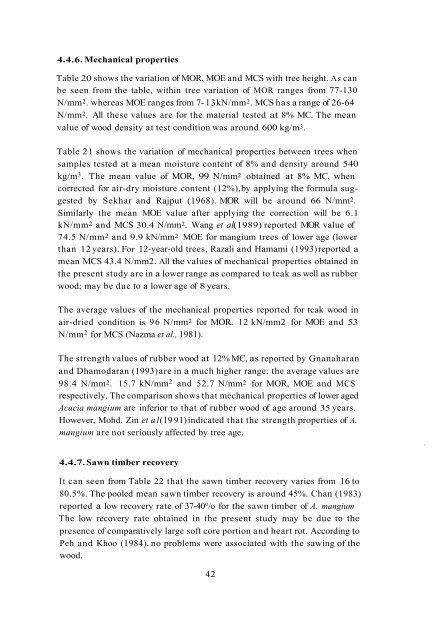growth and wood characteristics of acacia mangium grown in kerala
growth and wood characteristics of acacia mangium grown in kerala
growth and wood characteristics of acacia mangium grown in kerala
- No tags were found...
You also want an ePaper? Increase the reach of your titles
YUMPU automatically turns print PDFs into web optimized ePapers that Google loves.
4.4.6. Mechanical propertiesTable 20 shows the variation <strong>of</strong> MOR, MOE <strong>and</strong> MCS with tree height. As canbe seen from the table, with<strong>in</strong> tree variation <strong>of</strong> MOR ranges from 77-130N/mm 2 . whereas MOE ranges from 7- 13 kN/mm 2 . MCS has a range <strong>of</strong> 26-64N/mm 2 . All these values are for the material tested at 8% MC. The meanvalue <strong>of</strong> <strong>wood</strong> density at test condition was around 600 kg/m 3 .Table 21 shows the variation <strong>of</strong> mechanical properties between trees whensamples tested at a mean moisture content <strong>of</strong> 8% <strong>and</strong> density around 540kg/m 3 . The mean value <strong>of</strong> MOR, 99 N/mm 2 obta<strong>in</strong>ed at 8% MC, whencorrected for air-dry moisture content (12%), by apply<strong>in</strong>g the formula suggestedby Sekhar <strong>and</strong> Rajput (1968). MOR will be around 66 N/mm 2 .Similarly the mean MOE value after apply<strong>in</strong>g the correction will be 6.1kN/mm 2 <strong>and</strong> MCS 30.4 N/mm 2 . Wang et al(1989) reported MOR value <strong>of</strong>74.5 N/mm 2 <strong>and</strong> 9.9 kN/mm 2 MOE for <strong>mangium</strong> trees <strong>of</strong> lower age (lowerthan 12 years). For 12-year-old trees, Razali <strong>and</strong> Hamami (1993) reported amean MCS 43.4 N/mm2. All the values <strong>of</strong> mechanical properties obta<strong>in</strong>ed <strong>in</strong>the present study are <strong>in</strong> a lower range as compared to teak as well as rubber<strong>wood</strong>; may be due to a lower age <strong>of</strong> 8 years.The average values <strong>of</strong> the mechanical properties reported for teak <strong>wood</strong> <strong>in</strong>air-dried condition is 96 N/mm 2 for MOR. 12 kN/mm2 for MOE <strong>and</strong> 53N/mm 2 for MCS (Nazma et al., 1981).The strength values <strong>of</strong> rubber <strong>wood</strong> at 12% MC, as reported by Gnanaharan<strong>and</strong> Dhamodaran (1993) are <strong>in</strong> a much higher range; the average values are98.4 N/mm 2 . 15.7 kN/mm 2 <strong>and</strong> 52.7 N/mm 2 for MOR, MOE <strong>and</strong> MCSrespectively. The comparison shows that mechanical properties <strong>of</strong> lower agedAcacia <strong>mangium</strong> are <strong>in</strong>ferior to that <strong>of</strong> rubber <strong>wood</strong> <strong>of</strong> age around 35 years.However, Mohd. Z<strong>in</strong> et al(l99 1) <strong>in</strong>dicated that the strength properties <strong>of</strong> A.<strong>mangium</strong> are not seriously affected by tree age.4.4.7. Sawn timber recoveryIt can seen from Table 22 that the sawn timber recovery varies from 16 to80.5%. The pooled mean sawn timber recovery is around 45%. Chan (1983)reported a low recovery rate <strong>of</strong> 37-40°/o for the sawn timber <strong>of</strong> A. <strong>mangium</strong>The low recovery rate obta<strong>in</strong>ed <strong>in</strong> the present study may be due to thepresence <strong>of</strong> comparatively large s<strong>of</strong>t core portion <strong>and</strong> heart rot. Accord<strong>in</strong>g toPeh <strong>and</strong> Khoo (1984). no problems were associated with the saw<strong>in</strong>g <strong>of</strong> the<strong>wood</strong>.42
















